#gela mikava
Explore tagged Tumblr posts
Text
The Evolution and Impact of Contemporary Art
Contemporary art, a vibrant and dynamic field, transcends traditional boundaries to explore new mediums, themes, and techniques. It encompasses artworks created from the mid-20th century to the present day, reflecting diverse cultural, social, and political landscapes. This article delves into the multifaceted nature of contemporary art, its evolution, and its impact on society.
The Evolution of Contemporary Art

Contemporary art emerged in the post-World War II era, a time marked by rapid technological advancements and significant socio-political changes. This period saw a departure from the conventions of modern art, embracing a more experimental and inclusive approach. Key movements that paved the way for contemporary art include Abstract Expressionism, Pop Art, Minimalism, and Conceptual Art.
Abstract Expressionism
Abstract Expressionism, primarily an American movement of the 1940s and 1950s, emphasized spontaneous, automatic, or subconscious creation. Artists like Jackson Pollock and Mark Rothko focused on expressing emotions and ideas through abstract forms and bold colors. This movement laid the groundwork for future artists to explore new ways of conveying meaning beyond traditional representation.
Pop Art
In the 1960s, Pop Art emerged as a reaction to the elitism of Abstract Expressionism. Artists like Andy Warhol and Roy Lichtenstein drew inspiration from popular culture, mass media, and consumerism. Their works often featured everyday objects, celebrities, and advertisements, challenging the distinction between "high" and "low" art.
Minimalism and Conceptual Art
Minimalism and Conceptual Art, emerging in the late 1960s and 1970s, further expanded the boundaries of contemporary art. Minimalist artists like Donald Judd and Agnes Martin focused on simplicity, using geometric forms and industrial materials. Conceptual artists like Sol LeWitt and Joseph Kosuth emphasized ideas over aesthetic value, often creating works that required audience interaction or interpretation.
Themes and Techniques in Contemporary Art
Contemporary artists continue to explore a wide range of themes and techniques, often addressing critical issues such as identity, globalization, technology, and the environment. Their works challenge viewers to rethink their perceptions and engage with complex social and political narratives.
Identity and Representation
Identity is a recurring theme in contemporary art, with artists exploring race, gender, sexuality, and cultural heritage. For instance, Kehinde Wiley's vibrant portraits celebrate Black identity, while Cindy Sherman's self-portraits challenge traditional notions of femininity and self-representation.
Globalization and Technology
The impact of globalization and technology on society is another significant theme. Artists like Ai Weiwei and Hito Steyerl examine the implications of digital culture, surveillance, and the global flow of information. Their works often incorporate digital media, video, and interactive installations, reflecting the increasingly interconnected world.
Environmental Concerns
Environmental issues are also prominent in contemporary art. Artists like Olafur Eliasson and Agnes Denes create works that highlight the urgency of climate change and the human relationship with nature. These pieces often use natural materials and immersive installations to foster a deeper connection with the environment.
The Impact of Contemporary Art on Society
Contemporary art plays a crucial role in shaping cultural discourse and fostering social change. By addressing pressing issues and challenging societal norms, contemporary artists encourage critical thinking and inspire action.
Cultural Dialogue
Contemporary art facilitates cross-cultural dialogue, promoting understanding and empathy among diverse communities. Exhibitions and biennials, such as the Venice Biennale and Documenta, bring together artists from around the world, creating platforms for cultural exchange and collaboration.
Social Activism
Many contemporary artists use their work as a form of social activism, raising awareness about human rights, social justice, and political oppression. For example, Banksy's provocative street art and JR's large-scale photographic installations draw attention to marginalized communities and global inequalities.
Public Engagement
Contemporary art often extends beyond traditional gallery spaces, engaging with the public in innovative ways. Public art installations, participatory projects, and community-based initiatives create opportunities for people to interact with art in their everyday lives, fostering a sense of collective ownership and participation.
Conclusion
Contemporary art, with its diverse range of themes, techniques, and perspectives, reflects the complexity of the modern world. It challenges conventional boundaries, fosters cultural dialogue, and encourages social change. As we continue to navigate an ever-evolving landscape, contemporary art remains a powerful tool for understanding and engaging with the world around us.

7 notes
·
View notes
Text

artist to invest in now. Abstracted Face in pink by Gela Mikava
2 notes
·
View notes
Text
Georgian traditional clothing

The Roots series. Traditional clothing by Gela Mikava
Traditional lifestyles developed around the local climate and terrain, which in turn precipitated the creation of conventional clothing. Although every region of Georgia possessed its own distinct attire, an overarching similarity was seen in the chokha (Russian: cherkeska), a wool coat typically worn by men and noted for the cartridge holders sewn onto the chest. Women’s clothing was much more varied between the regions, particularly in the remote mountain communities.
Prince Vakhushti Batonishvili (1696–1757) paved the way in the study of traditional Georgian clothing, giving particular attention to the attire from medieval times and that of his own generation. Foreign travelers such as Arcangelo Lamberti and Jean Chardin also made notable contributions to the topic. The latter travelled to Georgia in the 1670s, and his remarkably detailed notes provide valuable insights into local clothing of that time as well as the similarities and differences between Persian, Georgian and European attire.
Thanks to these and other such historical records, a picture of traditional Georgian clothing from each region of the country may be pieced together today.
Traditional Clothing of Kartli-Kakheti
According to Vakhushti Batonishvili, people from Kakheti and Kartli had similar clothing styles. For men in Kartli-Kakheti, the primary piece of apparel was the chokha. The Kartli-Kakheti chokha was longer than that of neighboring Khevsureti and had a triangular opening at the neck to reveal an inner cloth. The chokha, worn without a belt by men, included a slitted skirt and miniature pockets on either side of the chest that were traditionally loaded with bullets. The Kartli-Kakheti chokha was usually tan, blue, black or red in color.
In keeping with conservative Georgian culture at that time, women in Kartli-Kakheti wore long dresses with beautiful ornate bodices. The dress was tightened at the waist with a richly decorated belt that draped almost to the end of the skirt. The most important aspect of the outfit was the headdress, which was defined by a triangular white veil of tulle, a velvet rim and a dark headscarf.
Traditional Clothing of Pshav-Khevsureti
Clothing in Georgia’s mountain regions was made of a durable wool fabric that provided protection against harsh alpine conditions. Despite its practical nature, the apparel was always beautifully decorated, as women in Pshav-Kvevsureti were trained from childhood in wool processing and dyeing.
Kvevsureti’s chokha, known as talavari, were short with slits running down to the waist and a beautifully decorated fabric affixed to the front. Men’s outfits typically consisted of knitted pants called pachichebi, woven fiber shoes known as tatebi and chokha with colorful religious symbols embroidered on the front.
Traditional women’s dresses in Khevsureti were called sadiatso. Sadiatso were knee-length dresses decorated with baubles and sophisticated geometric patchwork. Just like their Kartli-Kakhetian neighbors, women in Khevsureti wore a headdress. Traditional Khevsur headdresses were greatly admired and decorated with cross-shaped ornamental patterns. Pshav and Khevsur women would also wear silver coins and cross necklaces.
Traditional Clothing of Tusheti
Tusheti’s highland inhabitants were known for their use of wool in making clothes, shoes and rugs, with solar symbols and crosses regularly employed in their remarkable clothing and jewelry designs.
Both women and men in Tusheti wore colorfully knitted shoes called chitebi. Men’s chitebi were plainer with polka dots, while women’s chitebi were striped and multicolored. When making chitebi, the weaver would start from the tip of the shoe and continue backwards towards the heel. Chitebi shoes also played a role in local superstition: On a Wednesday during Lent, mothers would put male chitebi under the pillow of their daughters right before they went to sleep, in the hope that they would see their future husband in their dreams.
Traditionally, a Tushetian woman wore a black headscarf which reached down to her knees, a loose-fitting dress underneath her robe and an outer garment adorned with jewelry across the chest. Men’s clothing consisted of a chokha and a warm black hat.
Traditional Clothing of Svaneti
No discussion of Georgian traditional clothing would be complete without mentioning Svaneti’s famous hats. Svan hats were usually gray with black seams. Each hat was made from 200 grams of sheep’s’ wool and took about 30 hours to complete. The black seams were cross-shaped and reflected the popular Svan greeting , “May the cross protect you”. Svan hats were valued for providing warmth from winter’s chill and respite from summer heat.
Traditional Svan clothing consisted of a shirt, chokha, trousers and Svan hat. Women wore a woolen dress and headdress adorned with earrings and jewelry, while those who were wealthy also wore silk shirts and a velvet cloak.
Traditional Clothing of Racha
Iakob Gogebashvili, a leading 19th-century Georgian pedagogue, described female outfits from Racha in one of his writings, noting that they wore the chokha and an akhalukhi undershirt.
Women’s clothing from Racha also attracted the attention of many foreign travelers. In 1874, German scientist Dr. W. B. Pfaff could not hide his astonishment towards women’s clothing in Racha, exclaiming “I was amazed by the variety of women’s clothing, which in many ways reminds me of Anatolia”. In 1874, English explorer Philip Grove, upon seeing three local women, also noted “They wore short dresses and trousers…with grace”.
Apparently men’s attire in Racha was less noteworthy, as little information has reached us today regarding their traditional style of dress.
Traditional Clothing of Adjara and Guria
Traditional Georgian men’s clothing in the western Adjara and Guria provinces differed dramatically from that of eastern Georgia. The typical men’s outfit in Guria-Adjara, Samegrelo and the whole of southwest Georgia was the chakura, which consisted of a short waist-length chokha, wide-brimmed trousers and a colorful silk belt.
Throughout the ages, women in Adjara have worn three types of dresses. Zubun-faraga, the oldest of the three, derived its name from the Turkish word zubuni, meaning “coat”. The dress was long and hemmed in at the waist, with special attention paid to lavish embellishments on the bodice. A zubun-faraga dress can be seen today on display at the Simon Janashia Museum in Tbilisi.
The zubun-faraga dress was gradually replaced by the datexili dress, which was recognizable by its long, wrinkled appearance and multicolored threads worked into the fabric. It was tightly fitted to the body and had hidden pockets sewn into the wrinkles. In later years, the datexili dress evolved into a new variation known as the forka dress.
Traditional Georgian Shoes
Traditional Georgian shoes were typically made using muted colors of black, red, green and light brown. The 17th-18th century Georgian diplomat Sulkhan-Saba Orbeliani mentions several types of local shoes in his writings:
Tsugha were worn at home by both men and women. They were sewn from leather of various colors and the edges beautifully decorated.
Kalamani were common leather shoes worn by villagers beginning in the 10th-11th centuries.
Mogvi were tall leather boots worn by kings and nobles.
Additional Information
The best places to see Georgian traditional clothing today are at the Art Palace of Georgia (formerly known as the Museum of Cultural History) and at the Simon Janashia Museum, both located in Tbilisi. Traditional clothing, which has slowly been making a comeback in the 21st century, is also sometimes donned at Georgian traditional weddings and cultural events.
The Day of National Dress in Georgia is a recently established holiday celebrated on the 18th of May. In commemoration of their heritage, Georgian dancers and ordinary people alike dress in national costumes and march across the city to demonstrate the beauty of traditional Georgian attire. If you are visiting Georgia during this time, be sure to join the celebration to become familiar with diverse costumes from every region of Georgia!
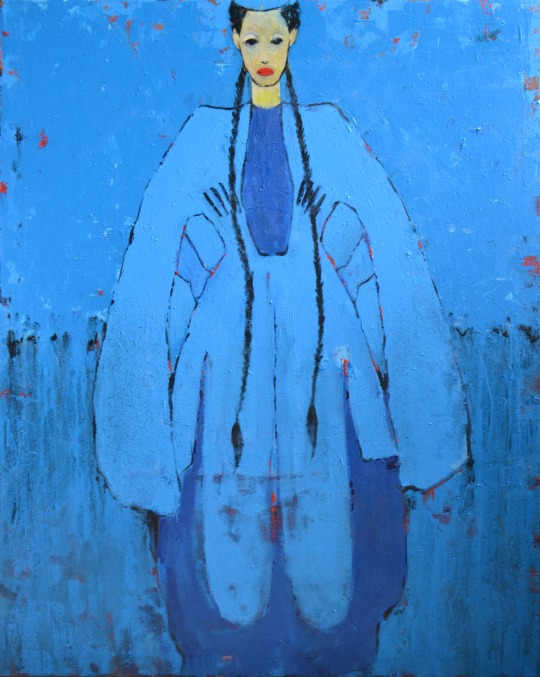




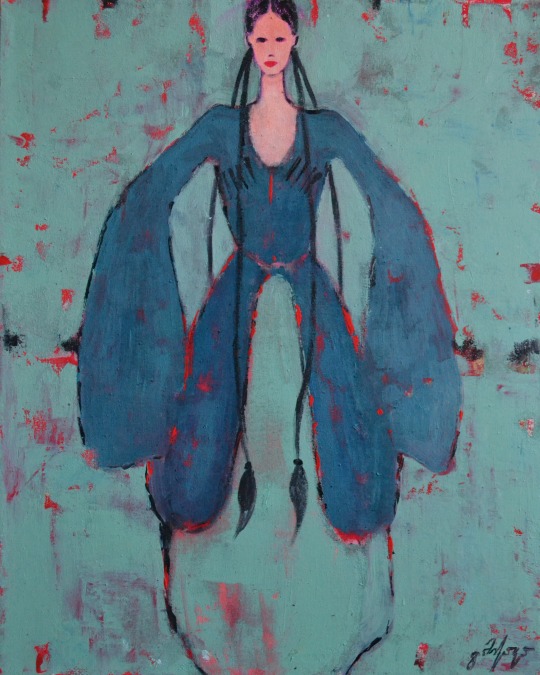


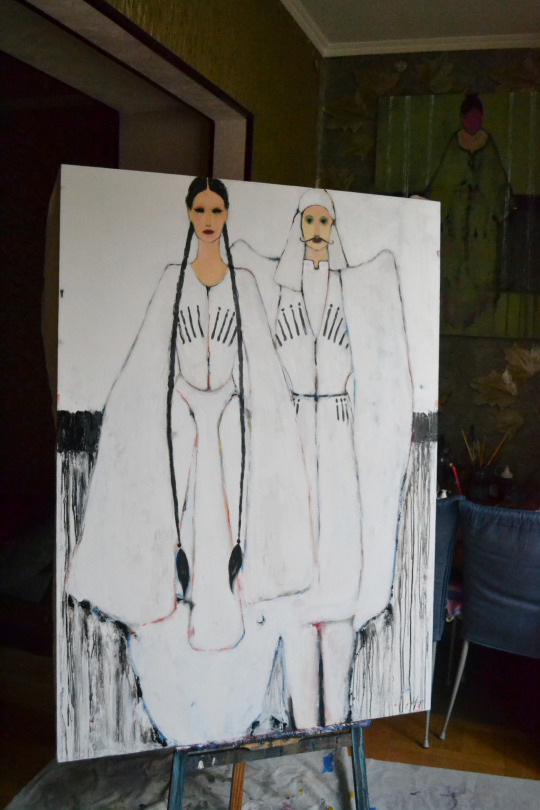
3 notes
·
View notes
Photo







(via “Gela Mikava: 2023-cü ildə diqqət yetiriləcək yeni nəsil müasir incəsənətçi, tənhalıq və əlaqəni araşdırır”)
2 notes
·
View notes
Text
Discover the Contemporary Genius: Gela Mikava

When exploring the world of contemporary art, one name that stands out is Gela Mikava. This young Georgian artist has carved a niche for himself with his innovative use of Soviet-era materials and exploration of historical and cultural themes. Here’s why Gela Mikava should be on your radar.
Innovative Artistic Approach

Themes of History and Memory
Mikava’s art delves into themes of history and memory, offering a poignant reflection on the past. His works often evoke a sense of nostalgia, encouraging viewers to reflect on their own experiences and cultural heritage. This thematic depth makes his art both intellectually and emotionally engaging.
International Recognition

Contemporary Art and Cultural Heritage
Mikava’s work is a bridge between the past and the present, blending traditional Georgian motifs with contemporary techniques. This synthesis of old and new makes his art relevant and thought-provoking, resonating with a wide audience both in Georgia and internationally.
Why Gela Mikava is a Must-See Contemporary Artist

1 note
·
View note
Link
Gela Mikava: Architectural Visionary Turned Contemporary Art Phenomenon
In the dynamic realm of contemporary art, where boundaries are constantly pushed and perceptions challenged, one name has emerged as a beacon of innovation and creativity: Gela Mikava. Hailing from the vibrant city of Tbilisi, Georgia, Gela Mikava has swiftly risen to prominence, captivating audiences worldwide with his distinctive blend of architectural insight and artistic expression.
Born on November 16, 1995, Mikava’s journey into the realm of art began with a solid foundation in architecture. Armed with both bachelor’s and master’s degrees from the Technical University, his early training laid the groundwork for a multidisciplinary approach that defies convention and embraces experimentation.
Mikava’s artistic oeuvre is a testament to his boundless creativity and relentless pursuit of excellence. Exhibiting his work in prestigious venues across the globe, including the Affordable Art Fair and Battersea Art Fair in London, Mikava’s presence on the international stage is undeniable. Notably, he made history as the youngest artist featured at the Hessinck Live Auction in the Netherlands, where his paintings commanded attention alongside the works of iconic figures like Andy Warhol and Banksy.
At the heart of Mikava’s artistic practice lies a fascination with texture, form, and color. Employing a diverse array of mixed media, including textiles, cellophane, oil, acrylic, pastel, and marker, he creates immersive works that blur the lines between painting and sculpture. Each piece is a symphony of hues and shapes, inviting viewers into a world where beauty and meaning intertwine.
Thematically, Mikava’s work navigates the intricacies of existential and political discourse. Through bold imagery and provocative symbolism, he confronts the fundamental questions of human existence, urging viewers to contemplate their place in the world. It is this fusion of aesthetic allure and intellectual depth that distinguishes Mikava as a visionary artist for the modern age.
Driven by a relentless desire for artistic evolution, Mikava remains at the forefront of ultra-contemporary art. With each new creation, he pushes the boundaries of his craft, challenging both himself and his audience to embrace the possibilities of the unknown. In an ever-changing landscape of global art, Gela Mikava stands as a testament to the enduring power of creativity and the boundless potential of the human spirit.
As he continues to shape the dialogue of contemporary art, Mikava’s vision serves as an inspiration to aspiring artists and seasoned connoisseurs alike. With unwavering dedication and unbridled passion, he reminds us that art has the power to transcend boundaries, provoke thought, and transform lives. In the world of Gela Mikava, the journey is just beginning, and the possibilities are limitless.
0 notes
Text
The painting “The Abstract Face in Blue and Orange” by Gela Mikava

The painting “The Abstract Face in Blue and Orange” by Gela Mikava is a vibrant mixed-media piece that captures the viewer’s imagination. Here’s a detailed description:
Color Scheme: The artwork is a striking composition of blue and orange hues, which create a vivid contrast and draw the eye.
Abstract Imagery: The face in the painting is suggested rather than explicitly outlined, allowing for a multitude of interpretations by the viewer.
Upper Composition: The upper portion of the painting features a chaotic yet harmonious mix of dark and light blues, greens, blacks, and hints of red.
Facial Outline: A bold orange shade outlines what could be perceived as the contour of a face, adding definition to the abstract form.
Lower Composition: Below the abstract face, structured vertical lines in white and black provide a stark contrast to the fluidity above.
Texture and Depth: Splatters of paint across the canvas add depth and a sense of movement, contributing to the dynamic energy of the piece.
Mood: The overall mood of the painting is one of energetic dynamism, thanks to its bold color palette and vigorous brushstrokes.

“abstract face painting,” “blue and orange art,” “mixed media abstract,” and “dynamic expressionist painting”
8 notes
·
View notes
Text
Gela Mikava
Gela Mikava is a Georgian visual artist whose unique approach to artistry centers on repurposing Soviet-era cotton fabric stretch ceilings as his canvas of choice. In a world where materials are often discarded thoughtlessly, Mikava sees these ceilings as vessels of history, carrying the weight of generations' stories, emotions, and memories.
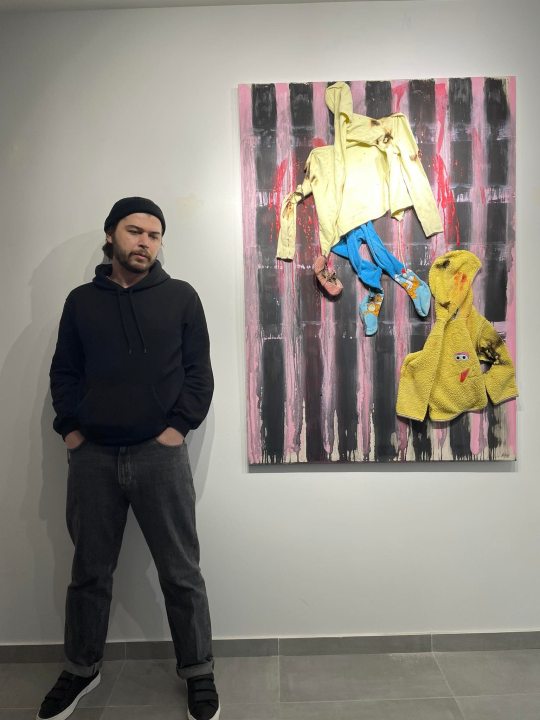
6 notes
·
View notes
Text
A new figurative abstract painting by GELA MIKAVA

This evocative piece is a narrative of resilience, power structures, and the invisibility of suffering in the shadow of authority. The top half of the painting features blurred and abstracted figures, seated and facing one another, reminiscent of policymakers or those in positions of control. Their undefined forms convey a sense of detachment, representing systems of governance that often fail to engage directly with the human cost of their decisions.

The muted, earthy palette, juxtaposed with sharp, shadowy tones, reflects a world where the human experience is obscured by the overwhelming presence of institutional forces. The interplay of abstraction and figurative detail suggests a disconnect between the personal and the political, urging viewers to consider the often-hidden consequences of societal structures on marginalized groups.

2 notes
·
View notes
Text

Contemporary expressionism of Gela Mikava.
Gela MIKAVA
2 notes
·
View notes
Text
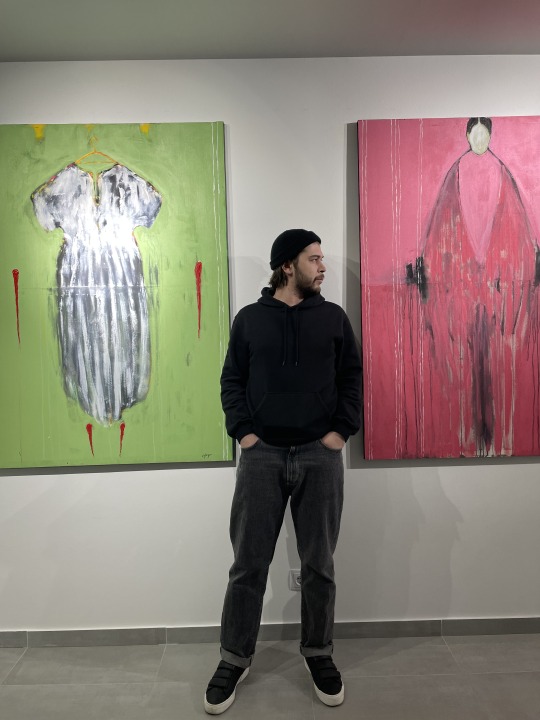
Gela Mikava is a Georgian visual artist whose unique approach to artistry centers on repurposing Soviet-era cotton fabric stretch ceilings as his canvas of choice. In a world where materials are often discarded thoughtlessly, Mikava sees these ceilings as vessels of history, carrying the weight of generations' stories, emotions, and memories.
3 notes
·
View notes
Text

Gela Mikava is a Georgian visual artist whose unique approach to artistry centers on repurposing Soviet-era cotton fabric stretch ceilings as his canvas of choice. In a world where materials are often discarded thoughtlessly, Mikava sees these ceilings as vessels of history, carrying the weight of generations' stories, emotions, and memories.
2 notes
·
View notes
Text
Gela Mikava-work in progress
The painting “The Abstract Face in Blue and Orange” by Gela Mikava
The painting “The Abstract Face in Blue and Orange” by Gela Mikava is a vibrant mixed-media piece that captures the viewer’s imagination. Here’s a detailed description:
Color Scheme: The artwork is a striking composition of blue and orange hues, which create a vivid contrast and draw the eye.
Abstract Imagery: The face in the painting is suggested rather than explicitly outlined, allowing for a multitude of interpretations by the viewer.
Upper Composition: The upper portion of the painting features a chaotic yet harmonious mix of dark and light blues, greens, blacks, and hints of red.
Facial Outline: A bold orange shade outlines what could be perceived as the contour of a face, adding definition to the abstract form.
Lower Composition: Below the abstract face, structured vertical lines in white and black provide a stark contrast to the fluidity above.
Texture and Depth: Splatters of paint across the canvas add depth and a sense of movement, contributing to the dynamic energy of the piece.
Mood: The overall mood of the painting is one of energetic dynamism, thanks to its bold color palette and vigorous brushstrokes.
“abstract face painting,” “blue and orange art,” “mixed media abstract,” and “dynamic expressionist painting”
#studio#gela mikava#art#painting#contemporary art#design#artistic#actors#museums#museum#travel#clip studio paint
2 notes
·
View notes
Text
#art#museums#design#artistic#museum#contemporary art#gela mikava#actors#travel#georgia#tbilisi#bidzina ivanishvili#sanction#usa#freedom#oligarchy
1 note
·
View note
Text
GELA MIKAVA: Capturing the Emotional Complexities of Contemporary Life

GELA MIKAVA’s artwork presents a powerful visual exploration of the psychological and emotional states defining today’s world. Through his distinct use of color and form, MIKAVA delves into the nuanced inner lives of individuals grappling with the complexities of modern identity, relationships, and self-awareness. His pieces often feature figures that appear ambiguous and fragmented, symbolizing the constantly shifting and uncertain identities people navigate in today’s fast-paced, media-driven culture.

A notable aspect of MIKAVA's style is his use of contrasting colors and intense expressions. These elements evoke feelings of isolation and anxiety that resonate deeply in an era where digital interactions frequently replace human connections. His works raise questions about the authenticity of relationships and self-perception in a world where technology often serves as an intermediary. By doing so, MIKAVA not only addresses the psychological pressures faced by individuals but also sheds light on the socio-emotional tensions characteristic of modern life.

Beyond exploring interpersonal and identity-based themes, MIKAVA's artwork frequently comments on the materialistic and status-driven motivations that can trap individuals in restrictive social frameworks. His figures, depicted with a dreamlike fluidity, seem to struggle against these societal limitations, expressing a longing for genuine freedom and self-discovery. Through his art, MIKAVA provides viewers with a symbolic journey that encourages them to confront their own emotional and psychological landscapes.

In essence, GELA MIKAVA’s work serves as a striking commentary on the human condition within contemporary society. His use of ambiguous forms and vibrant color schemes captures the complexity and depth of modern emotional experience, making his work both thought-provoking and deeply relatable.

0 notes
Text
GELA MIKAVA's Upcoming London Exhibition: A Reflection on Emptiness and Empathy
London, 2024 – Contemporary Georgian artist GELA MIKAVA is set to captivate London’s art scene with their new exhibition titled “Can Be Heard – The Silence, I See – The Nothing.” This highly anticipated solo exhibition will explore the complex interplay between emptiness and the human condition, challenging the way society prioritizes the void over empathy and human feelings.
The Concept Behind the Exhibition In “Can Be Heard – The Silence, I See – The Nothing,” MIKAVA delves into the existential tension between the physical and the emotional. The theme is a critique of how modern culture has become consumed by the allure of nothingness, often neglecting the richness of human emotions, empathy, and connection. MIKAVA reflects, “We give too much space to emptiness and nothingness, and too little to human feelings and empathy.”
The exhibition presents a visual meditation on this theme, with pieces that communicate through stark, minimalist compositions juxtaposed against emotional depth. Large canvases are dominated by open spaces, soft monochromes, and abstract figures, each inviting viewers to reconsider the void that dominates much of their internal and external lives.
Artistic Approach and Techniques Known for their symbolic use of form and space, MIKAVA’s works in this exhibition utilize both minimalism and abstraction to convey the tension between silence and what is often left unsaid. Many pieces feature muted color palettes—grays, blacks, and whites—that evoke a sense of quietness, almost as if the viewer is confronting an echo. However, the artist masterfully breaks the silence with sudden bursts of color or texture, representing the oft-ignored presence of human feelings buried beneath the surface.
In this way, MIKAVA's art emphasizes that within the "nothingness" society perpetuates, there is always a subtle presence of emotion waiting to be recognized.
A Personal Reflection of Our Times GELA MIKAVA’s exhibition comes at a moment when the world grapples with social disconnection, political upheaval, and a collective existential crisis. The themes of the exhibition speak to the alienation of the individual in a hypermodern world. Yet, by focusing on the neglected emotional core, MIKAVA urges viewers to reconnect with the empathy that binds us together.
Their work serves as a powerful reminder that the spaces we give to emptiness—whether in our physical environments, in digital interactions, or within ourselves—can often be filled with more meaningful expressions of empathy and human connection.
About the Artist Born in Tbilisi, Georgia, GELA MIKAVA has quickly risen to prominence in the global art scene. With a background in architecture and a unique ability to blend structured design with emotional expression, MIKAVA’s works have been featured in various international exhibitions. Their work often focuses on the intersection of form and being, and how individuals relate to the world around them, from a philosophical and emotional perspective.
This London exhibition marks a pivotal point in their career, further solidifying their place as a rising star in the world of contemporary art.
Event Details “Can Be Heard – The Silence, I See – The Nothing” will be on display at [Gallery Name] from [Dates]. Art enthusiasts, collectors, and critics are encouraged to attend the opening night for a chance to meet the artist and explore their latest body of work.

#art tag#digital art#drawings#illust#artwork#art#artists on tumblr#illustration#my art#gela mikava#abstracart
0 notes